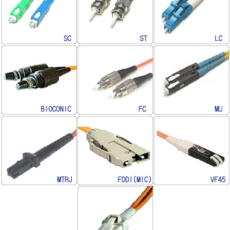UTP(Unshielded Twisted Pair) Cable
Cat3, Cat5, Cat5e, Cat6
Weakness on Electromagnetic Interference(EMI)
Installation Guide
– Avoid direct sunshine and humidity
– Enough distance from device in Electromagnetic environment
– Maximum distance
– Length of untwisted cable portion in the end is 11mm~13mm
– Length of opened sheath is less than 25mm
– Tensile of the cable is less than 11Kg
– Do not repair damaged cable
– Do not ban cable over 90 degree
STP(Shield Twisted Pair) Cable
Double covering cable
Cat7
Support higher bandwidth than UTP
Fiber Optic cable
Multi-mode cable
– Wide core size allows multiple fiber signals
– Core diameter is 62.5/125 micron
– Max distance is up to 5Km
Single- mode cable
– Narrow core size allows single fiber signal
– Core diameter is 5~10 micron
– Support long distance and high bandwidth
| Coax | STP | UTP | Fiber | |
| Bandwidth | 10~100Mbps | 100Mbps | 1G |
10G |
| Medium size | Large |
Normal | Small | Small |
| EMI | Good | Good | Weak | Strong |
| Max Length | 500m | 100m | 100m | 100Km |
| Cost | Cheap | Normal | Cheapest | Expensive |
– Propagation Delay
Propagation delay is amount of time it takes for a certain number of bits to be transferred thru a medium.
– Delay Skew;
Difference in time required by a signal to propagate in the same cable due to differences in the physical lengths of the pairs caused by different twist ratios. On UTP cables, there is 4 pairs cables, but none of pair has same physical lngths
– NEXT, Near-end crosstalk
Near-end Crosstalk is interference between two pairs of a cable measured at the same end of the cable as the transmitter. Crosstalk can be referred to electromagnetic interference from one unshielded twisted pair to another .




 The www.ipBalance.com runs by a volunteer group with IT professionals and experts at least over 25 years of experience developing and troubleshooting IT in general. ipBalance.com is a free online resource that offers IT tutorials, tools, product reviews, and other resources to help you and your need.
The www.ipBalance.com runs by a volunteer group with IT professionals and experts at least over 25 years of experience developing and troubleshooting IT in general. ipBalance.com is a free online resource that offers IT tutorials, tools, product reviews, and other resources to help you and your need.

![[Splunk] – Basic search fields and commands logo_splunk.png](https://ipbalance.com/wp-content/uploads/2009/06/logo_splunk-100x80.png)
